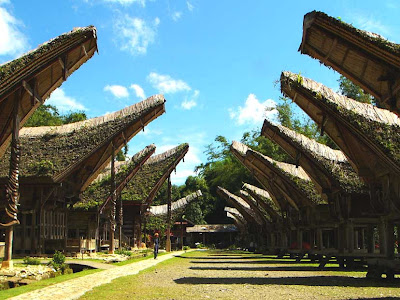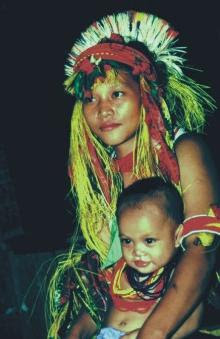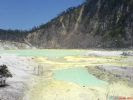Tana Toraja

SOUTH SULAWESI
The province of South Sulawesi comprises the narrow south-western peninsula of this orchid-shaped island which is mainly mountainous. The seafaring Bugis dominate the southern tip, whereas the northern part of South Sulawesi is inhabited by the Torajas whose unique culture rivals that of the Balinese. Famed for their seafaring heritage and Pinisi schooners for centuries, the Bugis possess to the present day one of the last sailing fleets in the world. The Bugis vessels have sailed to as far as the Australian coast, leaving behind drawings of their ships on stone with words that have been integrated into the Aboriginal language of north Australia. Situated on the crossroads of well traveled sea-lanes, its capital and chief trading port of Ujung Pandang, is till today the gateway to eastern Indonesia. Spanish and Portuguese galleons, followed by British and Dutch traders sailed these seas in search of the spice trade, escorted by their men of war to protect them against the daring raids of the Bugis and Makassarase who attacked the intruders.
Makassar, was formerly Makassar, well known for its Macassar oil from which the English word "antimacassar" evolved for small covers to protect upholstery. The fortifications which overlook the harbor were originally built in 1545. Gowa's most famous king is considered a national hero, named Sultan Hasanuddin, the 16th king of Gowa who waged a long and fierce war against the colonial forces.
Further north, through rugged country is Tana Toraja, often referred to as the "Land of the Heavenly Kings". An ethnic group who believes that their forefathers descended from heaven onto a mountain some twenty generations ago, the Torajas have a unique culture based on animistic beliefs. Known for their grand burial ceremonies on cliffs or hanging graves, they practice an ancestral cult even today where death and afterlife ceremonies are great feasts when buffaloes are sacrificed in the final death ceremony, after which the deceased's remains are placed in a coffin and interred in caves hollowed out in high cliffs.
The mouth of the cave is guarded by lifelike statues, looking out from a "balcony". As death has such an "important meaning" when the souls are released, burials are elaborate and follow days of feasting. Rock graves are also a form of burial. A strict hierarchy is followed in the villages.
"Tongkonan" (family houses) are built on stilts with roofs on each end rising like the prows of a ship, representing the cosmos. The mountains offer a fantastic panorama of natural beauty, including the long drive from Ujung Pandang to Tana Toraja.
MAKASSAR (FORMERLY UJUNGPANDANG)
The provincial capital of Ujung Pandang has in its history played an important role as the gateway to the former kingdom of Gowa and now to the whole province because of its natural harbor. The center of business and administration, the city has expanded outwards from its most important landmark, that of Benteng Ujung Pandang which faces the sea front.
One of the eleven fortresses of the kingdom, it was built in 1545 during the reign of Tuni Pallanga, the 10th sultan of Gowa. When Gowa capitulated to the colonial forces under the treaty of Bungaya in 1667, the fort was renamed Rotterdam by Admiral Speelman who constructed bastions and buildings of typical Dutch architecture making it the center of the civilian government, including a church on its premises. One of the best preserved forts of that area, only the thick walls of earth and stones remain of the original complex, now occupied by educational and cultural offices of the provincial government. The two buildings house the Ujung Pandang State Museum, exhibiting archaeological and historical objects, manuscripts, numismatics, ceramics and ethnic costumes and ornaments. Visiting hours of the museum are from 8.00 a.m. until 4.00 p.m. daily except on Mondays and public holidays. The fort itself is open daily till 17.00 p.m. Dedicated as a center of culture, the Conservatory of Dance and Music is located here and on the open stage in the center of the fort, dance classes for children can be seen in progress.
PAOTERE ANCHORAGE
On the outskirts of Ujung Pandang, Paotere is where sailing boats and other small vessels anchor to unload their cargo. The setting casts a glow over the sea with the silhouettes of the boats. This scenery is most often photographed by tourists.
SUNGGUMINASA
Formerly the seat of the kings of Gowa, about 11 km. from Ujung Pandang is the old palace of wood, standing on stilts facing the town square across the administration office. Now the Ballalompoa Museum, weapons and costumes of royalty are on display in glass cases. The royal regalia which includes a stone studded gold crown weighing 1769 grams can be seen only on special request.
BULUKUMBA
You will find white sandy beaches at Bira, 178 km from Ujung Pandang to the south. Traditional ship building is also located in this area. Not far from this area visitors can cross to the island of Selayar.
GOA MAMPU
The largest cave in South Sulawesi, the legendary cave of Mampu is about 140 km from the capital. Besides stalagmites and stalactites, rock formations resemble human figures and animals to which legends are attached. The cave is inhabited by bats who shriek and flutter around when bright lights pierce the darkness.
BANTIMURUNG
To the north of Ujung Pandang and driving east along the mountain range, is the Bantimurung waterfalls, about 41 km from the capital. A cascade of sparkling water gushes out between rocky cliffs into a stream shaded by tall trees. Here the air is filled with butterflies which fly from shrub to shrub over the water. These rare brightly colored ornithoid butterflies are considered the most beautiful in the world.
LEANG - LEANG
Now declared an archaeological site, these prehistoric caves have strange rock carvings of hands and a wild pigs, believed to be 5,000 years old. The road leads from Maros through the cave-riddled limestone hills to the site about half an hour's drive from the airport.
PARE - PARE
Pare-pare is a lunch stop along the road from Ujung Pandang to Toraja, through paddy-fields and typical Bugis houses made of wood and bamboo, built on stilts. Here we can find the museum Labangenge, located at jalan Bau Massepe No. 82, Pare-pare.
SENGKANG
The capital town of Wajo Regency is well-known for its silk weaving and therefore is the center of Buginese silk. This area is populated by the Buginese ethnic group, known for their crossing to other islands as traders of silk, sarongs and other material. Here we can find lake Tempe, one of the tourist resorts. Sailing and boating can be enjoyed on this lake.
SOPENG
Another center of the silk industry, this spinning mill produces thread from silk worms. Weaving can be seen in many private homes along this route which is 240 km to the northeast of Ujung Pandang. The finest silk is hand-loomed by village women who individually need a whole month to produce two meters of silk. Visitors are welcome to stop and watch, or make a purchase if there is any readily available.
THE TORAJA LAND
Tana Toraja (Toraja Land), which lies in the north of the province is known for its unique culture and ancient traditions. The center of tourism is Rantepao, 328 km from Ujung Pandang by road. There are several small bungalow hotels at Rantepao, and Makale, the district capital. The entry to Tana Toraja is marked by a gate built in traditional boat-shaped architecture. The road passes through the mountains of Kandora and Gandang on which, according to Toraja mythology, the first ancestors of celestial beings descended from heaven. The majority of the people still follows an ancestral cult called "Aluk Todolo" which governs all traditional ceremonies. From Rantepao, side trips can be made to Kete, a traditional village where there are handicraft and unique shops. Behind the village there is a grave site on a hillside. Life-size statues guard over old coffins.
src="http://pagead2.googlesyndication.com/pagead/show_ads.js">


Comments
Post a Comment